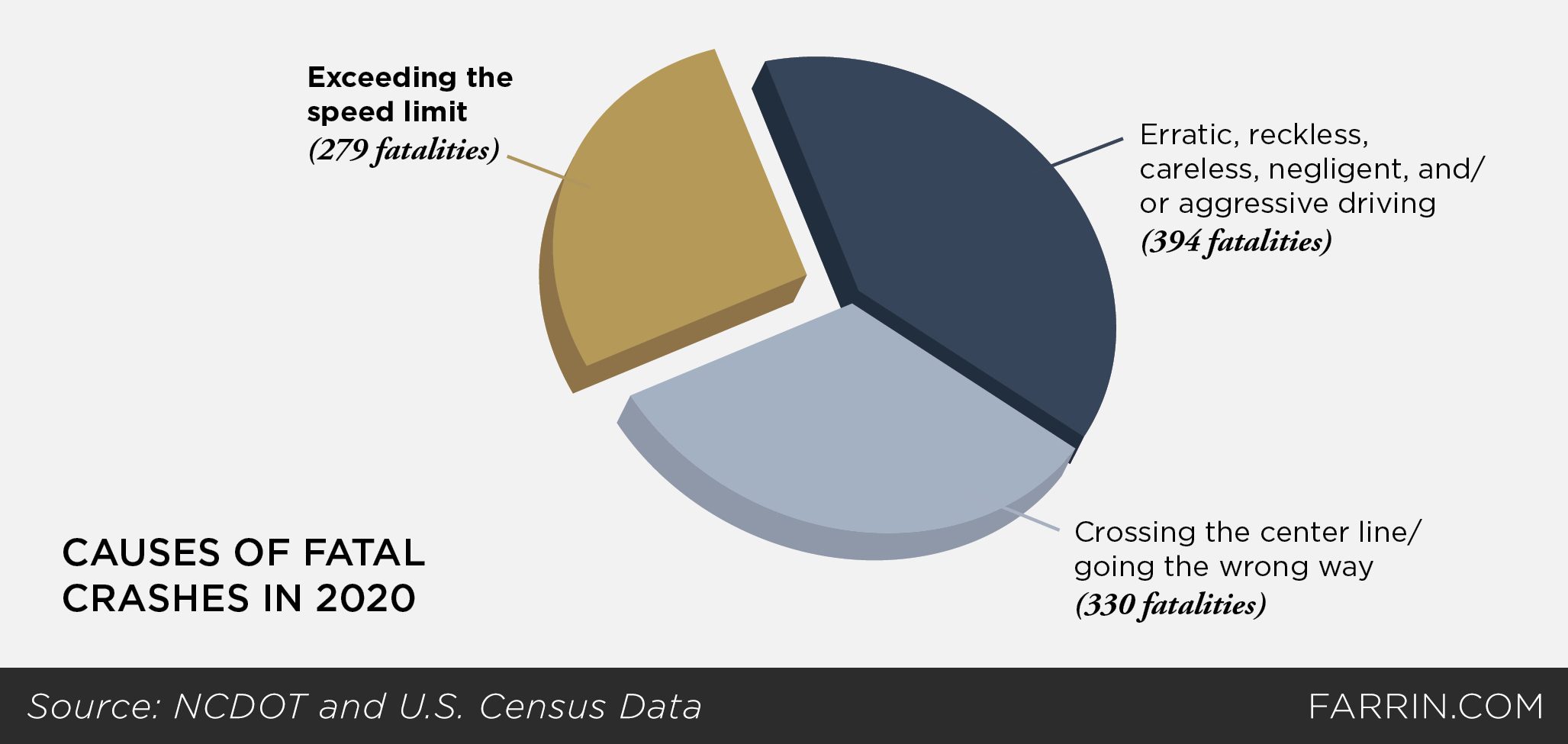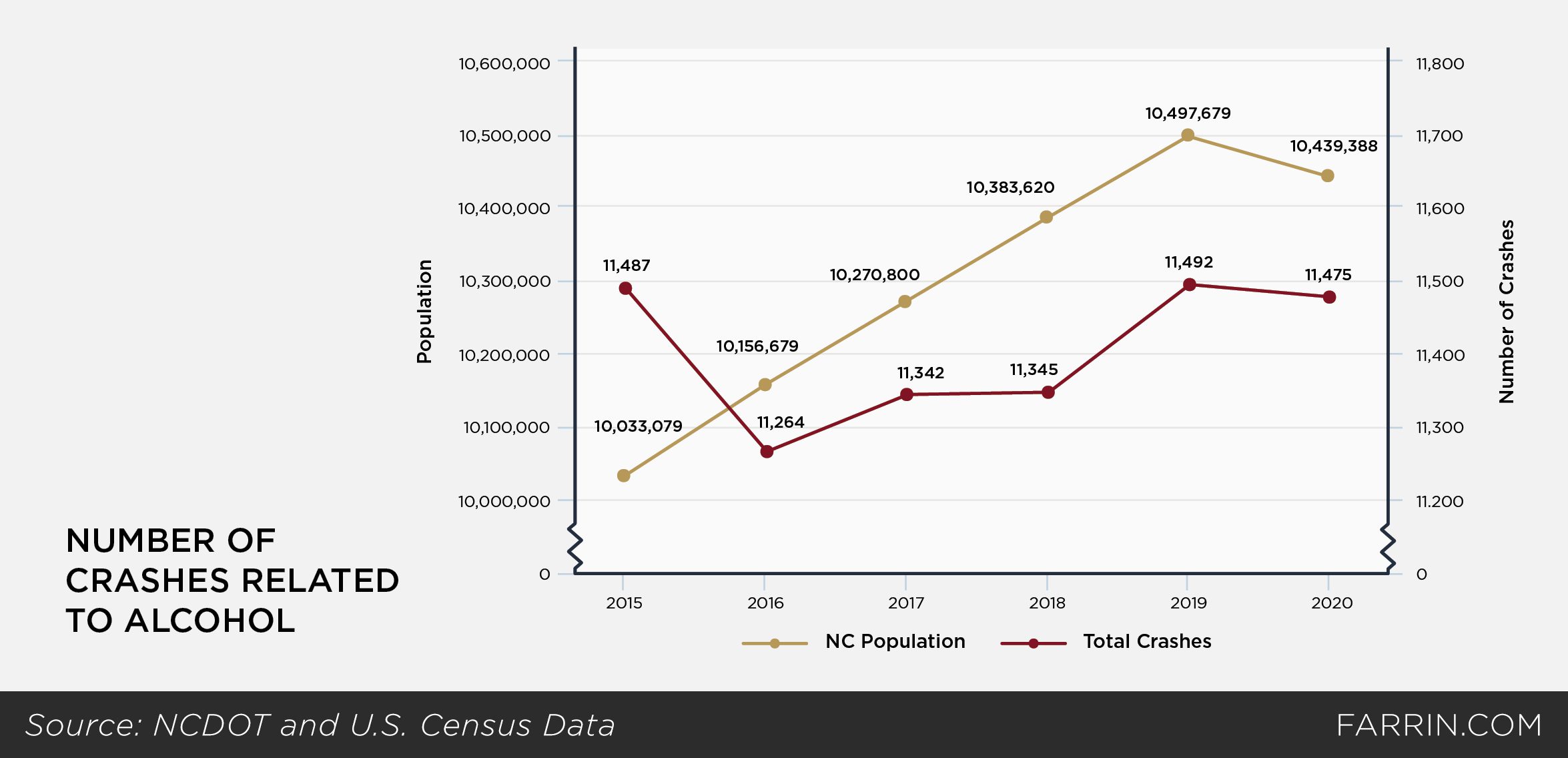For most of us, 2020 was the year of the pandemic, lockdowns, working from home, and generally a year when we traveled somewhat less than usual. As a result of fewer people on the roads, crashes were down significantly in 2020.
And yet, somehow, North Carolina drivers did a staggering amount of damage in 2020 – and were killed on the road at an alarming rate. So, in a year with fewer crashes, how did North Carolina end up with more fatalities on its emptier roads?
Top 10 Causes of Car Crashes in North Carolina in 2020
Using the NCDOT’s data, it’s easy to paint a very clear picture of what troubled North Carolina roads in 2020. The culprits in most crashes will seem familiar to almost anyone who has driven in the state.
Top 10 Contributing Circumstances – North Carolina Crashes (2020)*
- Failure to reduce speed (56,349)
- Inattention (41,349)
- Failure to yield (35,887)
- Going too fast (14,407)
- Reckless or negligent driving (12,933)
- Improper lane change (12,138)
- Car crossing centerline (9,287)
- Oversteering and overcorrections (10,653)
- Alcohol (8,492)
- Improper turns (8,283)
*When cause of crash is known. All numbers sourced from the NCDOT 2020 Crash Facts Report.
The two biggest contributing circumstances to crashes in North Carolina – speed and inattention, which can include distracted driving – were responsible for nearly as many crashes (97,698) as the next eight causes combined (112,080). If that seems like a lot, it is. However, in the previous year, speeding and inattention caused about 11,000 more crashes than the next eight causes combined.
Crashes did decline overall in 2020, but the number of fatalities significantly increased. And the number one cited cause of crashes – speed – played a deadly role.
More Open Roads, More Speeding
Across any ranking metric, speeding drivers were the genesis of a lot of the trouble on North Carolina roadways in 2020. Overall, if North Carolina drivers had kept to the speed limit, adjusted their speed for the conditions, and reduced their speed when necessary, there would have been about 30% fewer crashes in 2020. That’s nearly 75,000 crashes we could have avoided.
The top cause of North Carolina crashes in 2020 was drivers failing to reduce speed, with 25.1% of all crash fatalities related to speeding. Note that failure to reduce speed is not the same as “speeding” or exceeding the posted speed limit. The NCDOT classifies contributing circumstances fairly specifically. When you look at speed-related contributing, a pattern of crash severity and fatal injuries becomes clear.
Speed as a Contributing Factor in Crashes, Injuries, and Fatalities in 2020
| Crashes | Injury Crashes | Fatal Crashes | |
| Exceeded Authorized Speed Limit | 4,131 | 2,002 | 279 |
| Exceeded Safe Speed for Conditions | 14,407 | 4,318 | 107 |
| Failure to Reduce Speed | 56,349 | 17,186 | 127 |
| TOTAL SPEED RELATED | 74,887 | 23,506 | 513 |
| % of North Carolina Total Circumstances | 16.1% | 17.2% | 16.1% |
It’s important to note that more than one contributing circumstance can be cited in a crash, and that there can be (and often are) more than one injury or fatality in a given crash. Furthermore, law enforcement reporting is somewhat inconsistent, evidenced by more than a third of crashes (183,764) having no cited contributing factor.
In addition to contributing to the most total crashes in 2020 (56,349), failing to reduce speed contributed to the most crashes leading to injury (17,186). The list of circumstances most frequently contributing to fatal crashes looks a little different, but excessive speed – exceeding the speed limit – still makes an appearance.
Causes of Fatal Crashes in 2020
- Erratic, reckless, careless, negligent, and/or aggressive driving (394 fatalities)
- Crossing the center line/going the wrong way (330 fatalities)
- Exceeding the speed limit (279 fatalities)
Drunk Driving in 2020: Reversing a Trend in North Carolina
Unfortunately, the data shows that North Carolina regressed somewhat in terms of driving under the influence, at least in 2020. The percentage of crashes, injuries, and fatalities related to alcohol were all up from 2019, with 4,849 crashes involving a driver with a BAC level of at least .08 (legally impaired).
Number of Crashes Related to Alcohol
2015: 11,487
2016: 11,264
2017: 11,342
2018: 11,345
2019: 11,492
2020: 11,475
Those are strikingly consistent numbers across the years until you factor in the significant drop in total crashes from 2020 – drunk drivers appear to be a constant. The average number of crashes related to alcohol for the five years prior was 10,834. However, keep in mind that over that period the North Carolina population has continued to grow, so alcohol-related crashes per resident has been declining. This may indicate that drunk driver awareness campaigns are having an impact.
Distracted Driving in 2020: Trending in the Right Direction?
Drunk driving is not alone – there are similar awareness efforts focused on distracted driving. Those efforts seemed to have hit the same wall until 2020. From 2015-2019, the average number of crashes related to distracted driving was nearly 54,000. In 2020, the number of crashes was only 44,128.
Whether this was the beginning of a positive new trend or a temporary blip for distracted driving remains to be seen.
Slow Down, Stay Sober, and Pay Attention
It’s not complicated: safer roads are possible when people make better decisions when they’re driving. Speeding, inattention, and choosing to drive after drinking are all things we control, and therefore can eliminate.
You can find more insights gleaned from the NCDOT’s annual report in our analysis. Just make sure you pull over to read it.
You May Also Be Interested In
Answers to the Most Frequent and Urgent Car Accident Injury Questions
Distracted Driving Statistics: Shocking Numbers + Infographic
Driving Under the Influence: New Study Reveals Staggering Rates





